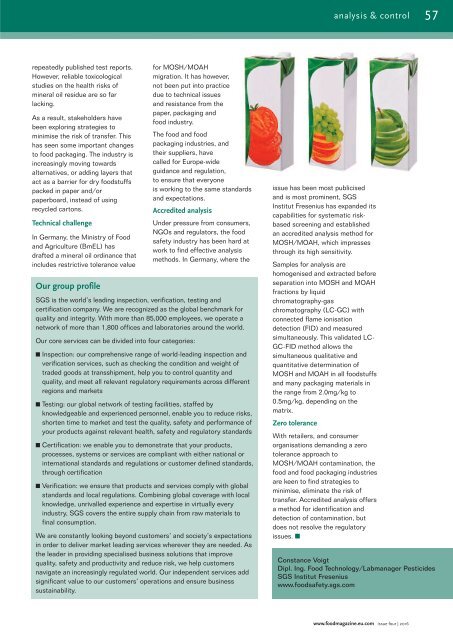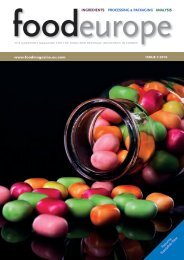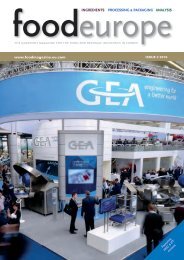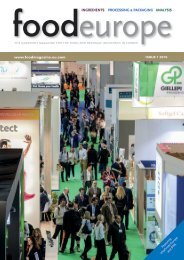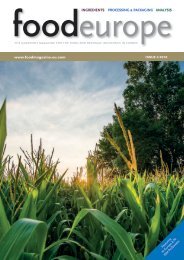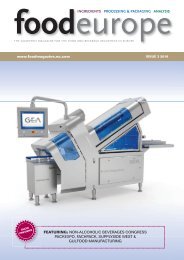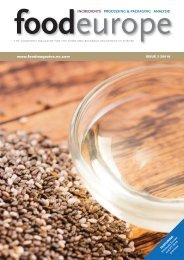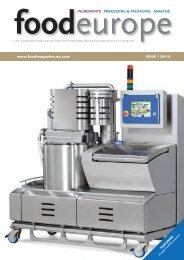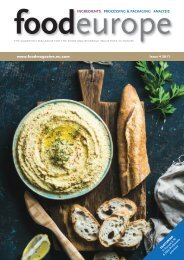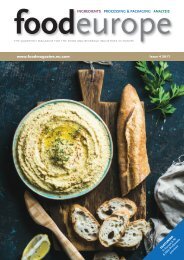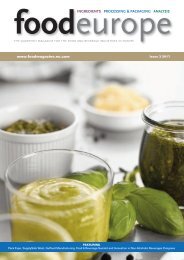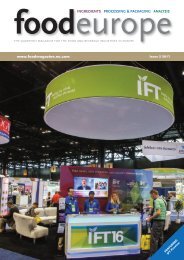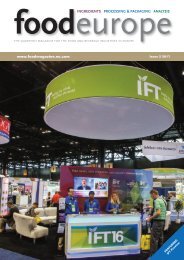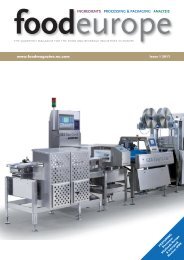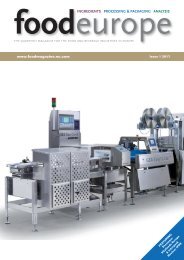FoodEurope Issue 4 2016
Create successful ePaper yourself
Turn your PDF publications into a flip-book with our unique Google optimized e-Paper software.
analysis & control 57<br />
repeatedly published test reports.<br />
However, reliable toxicological<br />
studies on the health risks of<br />
mineral oil residue are so far<br />
lacking.<br />
As a result, stakeholders have<br />
been exploring strategies to<br />
minimise the risk of transfer. This<br />
has seen some important changes<br />
to food packaging. The industry is<br />
increasingly moving towards<br />
alternatives, or adding layers that<br />
act as a barrier for dry foodstuffs<br />
packed in paper and/or<br />
paperboard, instead of using<br />
recycled cartons.<br />
Technical challenge<br />
In Germany, the Ministry of Food<br />
and Agriculture (BmEL) has<br />
drafted a mineral oil ordinance that<br />
includes restrictive tolerance value<br />
Our group profile<br />
for MOSH/MOAH<br />
migration. It has however,<br />
not been put into practice<br />
due to technical issues<br />
and resistance from the<br />
paper, packaging and<br />
food industry.<br />
The food and food<br />
packaging industries, and<br />
their suppliers, have<br />
called for Europe-wide<br />
guidance and regulation,<br />
to ensure that everyone<br />
is working to the same standards<br />
and expectations.<br />
Accredited analysis<br />
Under pressure from consumers,<br />
NGOs and regulators, the food<br />
safety industry has been hard at<br />
work to find effective analysis<br />
methods. In Germany, where the<br />
SGS is the world’s leading inspection, verification, testing and<br />
certification company. We are recognized as the global benchmark for<br />
quality and integrity. With more than 85,000 employees, we operate a<br />
network of more than 1,800 offices and laboratories around the world.<br />
Our core services can be divided into four categories:<br />
n Inspection: our comprehensive range of world-leading inspection and<br />
verification services, such as checking the condition and weight of<br />
traded goods at transshipment, help you to control quantity and<br />
quality, and meet all relevant regulatory requirements across different<br />
regions and markets<br />
n Testing: our global network of testing facilities, staffed by<br />
knowledgeable and experienced personnel, enable you to reduce risks,<br />
shorten time to market and test the quality, safety and performance of<br />
your products against relevant health, safety and regulatory standards<br />
n Certification: we enable you to demonstrate that your products,<br />
processes, systems or services are compliant with either national or<br />
international standards and regulations or customer defined standards,<br />
through certification<br />
n Verification: we ensure that products and services comply with global<br />
standards and local regulations. Combining global coverage with local<br />
knowledge, unrivalled experience and expertise in virtually every<br />
industry, SGS covers the entire supply chain from raw materials to<br />
final consumption.<br />
We are constantly looking beyond customers’ and society’s expectations<br />
in order to deliver market leading services wherever they are needed. As<br />
the leader in providing specialised business solutions that improve<br />
quality, safety and productivity and reduce risk, we help customers<br />
navigate an increasingly regulated world. Our independent services add<br />
significant value to our customers’ operations and ensure business<br />
sustainability.<br />
issue has been most publicised<br />
and is most prominent, SGS<br />
Institut Fresenius has expanded its<br />
capabilities for systematic riskbased<br />
screening and established<br />
an accredited analysis method for<br />
MOSH/MOAH, which impresses<br />
through its high sensitivity.<br />
Samples for analysis are<br />
homogenised and extracted before<br />
separation into MOSH and MOAH<br />
fractions by liquid<br />
chromatography-gas<br />
chromatography (LC-GC) with<br />
connected flame ionisation<br />
detection (FID) and measured<br />
simultaneously. This validated LC-<br />
GC-FID method allows the<br />
simultaneous qualitative and<br />
quantitative determination of<br />
MOSH and MOAH in all foodstuffs<br />
and many packaging materials in<br />
the range from 2.0mg/kg to<br />
0.5mg/kg, depending on the<br />
matrix.<br />
Zero tolerance<br />
With retailers, and consumer<br />
organisations demanding a zero<br />
tolerance approach to<br />
MOSH/MOAH contamination, the<br />
food and food packaging industries<br />
are keen to find strategies to<br />
minimise, eliminate the risk of<br />
transfer. Accredited analysis offers<br />
a method for identification and<br />
detection of contamination, but<br />
does not resolve the regulatory<br />
issues. n<br />
Constance Voigt<br />
Dipl. Ing. Food Technology/Labmanager Pesticides<br />
SGS Institut Fresenius<br />
www.foodsafety.sgs.com<br />
www.foodmagazine.eu.com issue four | <strong>2016</strong>


